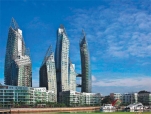Deconstruction: the Philosophy of Creativity

The capacities of modern building has a way more often allow the boldest construction ideas to come true in everyday life. Day by day architects find it more difficult to surprise and amaze the imagination of the sophisticated and gorged representatives of the “consumer society”. Sometimes, however, one can create a concept or a branch that steals the public attention for a long time. Deconstruction can be attributed to the category of such successful doctrines or even to the “philosophy of creativity”. Buildings that were constructed in the style of modern architecture abidingly cause broad public response, become local sights and the focal points of active urban life and even turn the decorations for new movies.
In architecture deconstruction emerged as a necessity to flee from conservatism and the mundane standard design during the strong social and cultural upheaval of Western civilization in the late 1960s. Subsequently this trend smoothly joined the broader concept of digital architecture; but it appeared in the “pre-computer era” and even encouraged many of its followers to seek support and develop new ideas by means of digital technologies. This is what makes it different from postmodernism that was initially formed as a theoretical and stylistic branch of architecture that was aside from the previous practice of design and construction and actively confronted it.
In the 1970s and early 1980s it was postmodernism that was particularly acute and popular both in theoretical research as well as the real architectural and construction practice. Therefore, the interest in another way to convert the conventional traditions, those of deconstruction, gradually took shape within almost two decades past the first mention in the professional vocabulary. “Deconstruction” as a term first appeared in the book “Of Grammatology” (1967) by the French philosopher Jacques Derrida (1930 - 2004). And as a literary-critical direction of the Yale school, “deconstruction” appeared in 1979, later on it expanded into other fields of science, culture and art. In 1988 it was emphasized in a separate exhibition in the Museum of Modern Art in New York (MoMA) that was accompanied by a program manifesto under the title “The Architectural Deconstruction.”
Philip Johnson, the founder and the leading representative of the “international style” in American architecture of the mid-XX century, invited several known by that time architects to participate in it. One could see it in the exhibits present at the MoMA that the basic ideas deconstructionists had aimed at leading architecture from the logic of post-and-beam systems and the visible structural clarity, sparing it from the dominating functionality in favor of the artistic concept, valuing the space as it is rather than the mass. Peter Eisenman is considered the founder of the new trend, and the participants of the exhibition were Wolf Prix and Helmut Swiczinsky from the Coop Himmelb(l)au Bureau, Frank Gehry, Daniel Libeskind, Bernard Tschumi, Rem Koolhaas and Zaha Hadid. It is easy to notice that today all these architects and their bureaus were in the past awarded the Pritzker Prize - the most prestigious international award in the field of architecture - are now among the most famous architects in the world. The exhibition received publicity for a long time and it allowed the architects to start realizing their ideas in real projects. Its participants highly valued the experience of the Russian avant-garde of the 1920s. But gradually they all interpreted the initially given aesthetic basis in their own way and to the greatest extent deviated from the principles of deconstruction of the “exhibition period”.
Each of the participants of the memorable exhibition of 1988 understands these ideas in his/her own way. To the Coop Himmelb(l)au architects the most important thing is the emotional element of the project. Wolf Prix never stops highlighting that the most important idea behind the projects of their bureau is the sensibility and the irresistibility, regardless of the stylistic expression. Regarded as the founders of the trend, the Coop Himmelb(l)au architects have, nevertheless, tried various styles throughout their career. They state that architecture should “burn, cry, smile, tear and even break… it should be wet, dry, smiling, stiff, angular, throbbing”. Their chamber projects appear to be the most prominent examples of deconstruction. However, their larger-scale projects are way calmer and closer to the conservative versions of the neo-modernism school. It is hard to believe that the projects of the UFA Cinema Center in Dresden (1993 - 1998), School 9 of Visual and Performing Arts in Los Angeles, CA (2002 - 2008) and the tower of the European Central Bank in Frankfurt (2004 - 2010) were created by the same group of designers. The seemingly arbitrary and chaotic mixture of volume that is characteristic of the first 2 buildings is opposed to the calm and geometrically even conservatism of forms of the European Central Bank.
Wolf Prix admits that he follows the ideas of deconstruction. He always highlights the importance of working on the subconscious level. “We started doing it deliberately in the mid-1970s when we were destroying the rational methods of thinking while designing, drawing with eyes shut and other means that could clear the space from any rational or economic structure and other clothing”. The urge to forget about gravity and to proceed with design where imagination has no limitations is the recipe of a new bright and descriptive architecture by the members of the Coop Himelb(l)au. (Vladimir Belogolovsky. Interview with Wolf Prix. Tatlin, 22.05.2009, № 2).
Full version you can download here
 Article by : MARIANNA MAYEVSKAYA
Article by : MARIANNA MAYEVSKAYA


